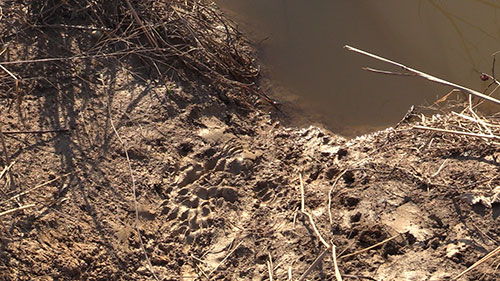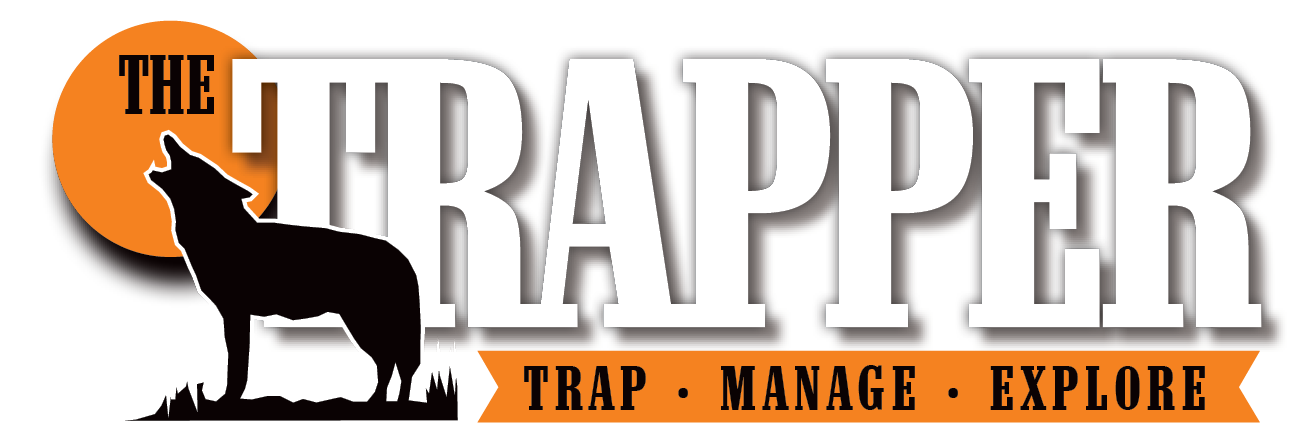Now is the time to get a jump on next year’s trapline. Here’s how to find your next best spots.
By Jason Houser
Scouting for furbearers, or as it is known in the trapping world, prospecting, has to be done if you want to catch large numbers of animals. With furbearer populations exploding in recent years, it can be difficult to narrow down where the highest concentrations of animals are.
Location, location, location — that is the key to catch any animal. It doesn’t matter how good the set is, if the animal isn’t there, you can’t catch it. That’s why it is so important to do your homework before the season — and even during the season — as conditions change.

A heavily used raccoon trail in farm country is easily recognizable when you learn what to look for. Photo credit Jason Houser.
When scouting, you are not just looking for “hot” spots to trap in the near future, but for spots to trap all season long. It does not take long if conditions are right for the area to go cold after you catch the “easy” animals. When this happens, trappers have to pull their traps and make sets in a new area. If trappers have to prospect each time they pull their sets, this can waste a lot of time. Time that will not allow trappers to trap, but instead spending time prospecting for new areas to trap. In the end, this means fewer pelts to sell. It is best to have new trapping ground planned well ahead of time.
Raccoons
Raccoons are one of the easiest animals to locate. They seem to be just about everywhere. The problem with prospecting for ‘coons is that their feeding habits can change very quickly. One day raccoons could be feeding on mussels and crayfish at a creek. The next day they might be feeding in a cornfield. The day after that you might find them eating acorns or berries. For this reason, it is best to wait until a week before you will begin trapping before you prospect.

Raccoons are always changing their food sources. It might be corn one night and berries the next. You have to stay on top of it. Photo credit Jason Houser.
Raccoons are found along streams with large trees. They live in hollow trees, woodchuck holes, abandoned and occupied farm buildings, and rocky ledges. They spend a lot of time along water searching for food during the summer and early fall. Later on they will move to cornfields, oak trees, berry patches, etc. Just because you do not see ‘coon tracks near water does not mean they are not in the area. It simply means they are feeding on other types of food.
Since raccoons den in trees, carefully look over every tree that appears to be hollow. Look for a trail leading from the tree toward water. Also, check out den locations such as hollow logs, rock formations and woodchuck holes.
Look for broken corn stalks at the edge of a field that is near water, especially the side of the field that is nearest to the water. Look for tracks, trails and scat. Raccoons cannot pass up holes along the bank of a water source. Drain tiles are also well liked by a curious raccoon. Sluices and culverts should also be inspected for tracks. Do not forget to inspect under bridges for ‘coon sign.
Wherever there is a stream with oak and beech trees nearby, the area will more than likely hold it share of raccoons. Look for overturned leaves that are evidence that they’re looking for nuts. The stream close to the trees will also be visited. Look for tracks in the muddy bank.
Large trees that stand by themselves near a creek or lake are also productive. Raccoons cannot seem to resist playing in these lone trees. Look for scat near the base of the tree as proof they are visiting the tree. Once found, make a dirt-hole set or use a dogproof trap.
Farm buildings, whether in use or abandoned, are favorite hangouts amongst raccoons. It does not matter if the farm is neat and tidy or overgrown, ‘coons will be there. Farms have everything they need to survive. Search for tracks, scat and trails leading to and from the buildings. Farmers are always happy to rid themselves of these pesky critters.
The trick to catching high numbers of raccoons is by finding what they are eating and where they are traveling. The vital key to this is knowing what ‘coon tracks and scat look like.
Coyotes, Foxes and Bobcats
Recently, I have started to rely heavily on trail cameras to scout during the off-season for these animals. I can’t think of a better way to figure out the travel patterns of these furbearers than having several cameras out, telling me what they are doing.

A good pair of optics is a valuable scouting tool for canines and felines. Photo credit Jason Houser.
With several cameras spread out over several counties, it isn’t practical for me to go and check them every week. So, I have been using the Tactacam Reveal Cellular Camera that sends the photos right to my phone. I am able to gather information that will prove useful when trapping season approaches, and then I can put boots on the ground to finalize my scouting.
When I am putting the final touches on deciding my trap locations, the first things I look for are tracks. This is great when the ground is soft or there is a layer of snow. But obviously tracks can be impossible to find when the ground is hard and dry.
Get out in the preseason whenever there are good tracking conditions and spend time looking over your trapping grounds. Search for tracks indicating preferred furbearer travel routes. Learn the difference between dog and coyote tracks. You do not want to waste your time setting on dog sign, thinking it was coyote sign.
Look for scat. Droppings are a good sign animals are in the area. The fresher the better. Also, look for hair on fences where critters are crossing under them.
Go out and travel the backroads with a good pair of optics to look for animal activity. When you spot a furbearer, watch what it does and where it goes. Keep notes of what you see on these road trips. Not only will you learn where the animals are, but you will learn more about how they act during their daily routines.

This coyote was easy to pattern, as the author received trail-camera photos of it every night. Photo credit Jason Houser.
If you happen to be a deer hunter, take advantage of what you see while hunting. Oftentimes, deer hunters have encounters with coyotes, foxes and bobcats. Remember where they come from and where they go. Watch the routes they take to get from one area to the next. Again, watch their habits, and learn from them.
Bobcats prefer large forested or wooded areas. Forest lands with immature trees, thick underbrush, clearings, cliffs and timbered swamps are generally best. Common den sites include fallen trees, hollow logs, thickets, caves and rock piles. Some bobcats make their dens in abandoned or little-used barns and buildings. Viewed by many as a “wilderness species,” the bobcat’s shy, secretive habits allow it to live surprisingly close to people.
Scout locations where canines and felines will hunt for food. Common foods include rabbits, squirrels, birds and rodents such as mice, voles and rats. These areas could be fencerows, field edges, CRP ground, old roads, etc.
Beavers, Otters, Muskrats and Mink
All three of these species are relatively easy animals to scout for. They can leave behind plenty of destruction from their everyday routines that I am sure most of you have noticed.

Beavers can inflict major flooding damage, and this is easy-to-spot evidence that they are in the area. Photo credit Jason Houser.
Beavers are known for their dam-building abilities, leaving surefire evidence of their presence. Combine this with the destruction from flooding that impacts forests, agricultural land, roadways, infrastructure and more, it is easy to find where beavers are active.
Once you find a location where there is good beaver sign, such as fresh cuttings, lodges and dams, you will need to do some closer scouting. Look for crossovers that the beavers are using to go from one body of water to another, their huts and other dams.
Otter and beaver habitat are like two peas in a pod. In fact, it is tough not to catch an otter while beaver trapping if any otters are in the area. I begin all my otter scouting near spillways and crossovers.
It is often said that otters are on a two- to three-week cycle traveling through an area, so it is possible that you might not find fresh sign right away. However, it is likely that the otters will return.
You can look for tracks, but one of the easiest ways to know that otters have been in the area is to find their toilets. These are quite easy to identify, especially if they have been preying on fish. The scat will be full of scales.
Many believe that otters are primarily water animals, but they will leave the water in search of food. They are meat eaters, so they will go on land in search of prey. Search for secondary trails on the bank where otters hunt for food.
Otters are known to take over abandoned beaver runs. Search for any sign of otter activity. It might be something as small as a few claw marks left in the dry dirt.
Do not pass up anywhere that two watersheds come together. It might be something as small as a roadside ditch running into a creek, but if otters are in the area, they know about it.
Muskrats might not be as easy to scout as beavers from a distance, but a quick search from the bank of any body of water will tell you if muskrats are present.

Muskrat runs are easily identifiable. This muskrat was caught entering its home in the bank. Photo credit J3 Outdoorz.
One of the easiest things to look for are their huts. These usually protrude from the water a few feet and are much smaller in size compared to a beaver’s hut.
Also, search out feed beds, toilets and muskrat runs burrowing into the bank. Active muskrat runs are going to be shiny from all of the traffic that they receive. When ice begins to form, these runs will be noticeable from the air bubbles trapped underneath.
Since mink spend a lot of time traveling the water’s edge, some of the best places to scout are in the mud. The tracks of a mink will leave behind toe prints that are pointed and pear shaped, and normally their claw marks are visible. I usually compare a mink track to that of a house cat or otter, only smaller. Mink males are larger than females and this will be reflected in their track size.

Mink are tiny animals but leave plenty of sign; primarily their tracks and scat. Photo credit Jason Houser.
Another indication that mink are present is the scat they leave behind. Their scat is 2 to 3 inches in length and less than 1/2 inch in diameter. It’s common for mink to leave droppings on prominent objects and features in their territory.
Figuring out the behavior of your target animals and where they are throughout the season requires a lot of hard work. It isn’t something that happens overnight, but you will get out of it what you put into it. If you spend the time to scout, not just during the season, but in the weeks and months leading up to it — you will catch more fur.




